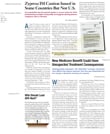Instead of establishing a traditional one-on-one clinician-patient relationship to treat children with mental illness in a clinical setting, the“ wraparound process” builds on the natural supports in a child's life and eschews the notion that “doctor knows best.”
Wraparound is a “value-based” approach to delivering services to children with severe mental illness and their families that empowers them and connects them to the community, said Charles Huffine, M.D. He is medical director for child and adolescent programs at the King County Mental Health, Chemical Abuse, and Dependency Services Division and a consultant to the Blended Funding Project, which embodies the principles of wraparound (see article above).
Explaining what he meant by value based, Huffine said it was having respect for the voices of families and “consumers,” cultural issues, and community standards.
According to Huffine, the term “wraparound” has been around for 20 years, but until recently had no clear definition. However, he said,“ with the publication of a Wraparound Fidelity Index we now have defining criteria that can be a basis for research.”
The index measures characteristics of wraparound services that a family receives in terms of adherence to wraparound service elements such as whether services are culturally competent, community based, and focused on the patient's strengths.
In the 1960s and 1970s, Huffine noted, there was an outcry from families whose children with mental illness had “fallen through the cracks of a poorly organized system and who demanded that care be family focused, individualized, and community based.”
To address these needs, Congress appropriated funds in 1984 for the Child and Adolescent Service System Program (CASSP), which was envisioned as a program that would lead each community to develop a comprehensive mental health “system of care” for children, adolescents, and their families.
Beth Stroul, M.Ed., and Robert Friedman, Ph.D., in 1986 co-wrote the monograph “A System of Care for Severely Emotionally Disturbed Children and Youth,” which outlined many of the principles behind CASSP.
Wraparound became a vehicle for putting those principles into action.
Huffine emphasized that “there is no treatment manual for wraparound.” When the term became popular in the late 1980s and 1990s, he noted, some programs proclaiming to practice wraparound referred to it as“ wrapping services around children,” but in reality, the concept and practice of wraparound is much more complex.
The wraparound process involves “mobilizing a unique set of community assets and natural supports in the child's life” to enable him or her to live and function successfully in the community, said Huffine.
Team-building is a central part of the wraparound process, and members of the team must be committed to the recovery of the child or adolescent with mental illness. The team is usually led by family members and can include peers, friends, and members of the community.
In addition, wraparound incorporates a strength-based approach to children and families, in which professionals and families focus not on the child's pathology, but on his or her strengths.
“We interpret anything a child does as a potential strength,” he said. “The most disruptive and oppositional child is often exercising some behaviors that if channeled in the right ways can improve his or her functioning and relationships with others.” ▪
